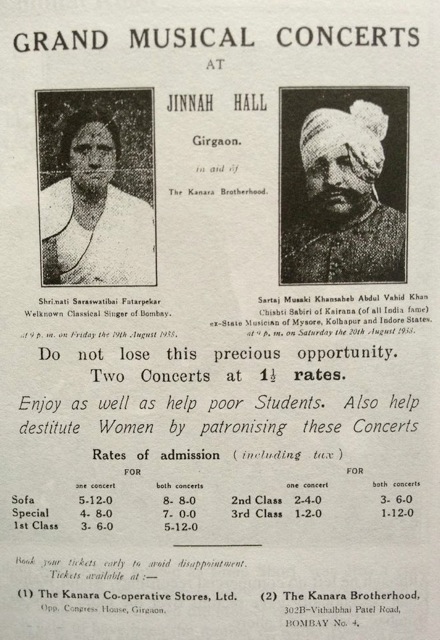It’s been some time since a guest post, but I am very happy to present a terrific selection by Toronto-based collector Chandan Narayan – enjoy! – JW
The mystery of this record rests in the biography of the singer. The late 19th and early 20th century Hindustani recording and performance circuit was rife with baiji-s[i], most notably, Kesarbai Kerkar (check out Ian Nagoski’s recent release of some of her classic 78s), Moghubai Kurdikar, Laxmibai Jadhav, and Gangubai Hanagal. While “Saraswatibai” would have not been an uncommon name at the time, the two Saraswatibai-s I encounter most often that were active around the time of this recording are the daughter of Abdul Karim Khan, Saraswatibai Rane, and his last wife, Saraswatibai Mirajkar. Given that these Saraswatibai-s were rather well-known singers, I concluded that Faterpekar was an alias of the better known Saraswatibai-s. However, a quick comparison with recordings of Rane and Mirajkar led me to conclude otherwise. So who was she?
The recorded output of Saraswatibai Faterpekar is likely scant given her relative obscurity in the literature. She’s never mentioned in the most common sources. There is one reference to a singer with the same name in K.P. Mukerji’s memoir The Lost World of Hindustani Music, which suggests that a Saraswatibai Faterpekar was a student of Ustad Khadim Hussain Khan of Bombay’s Bhendibazaar Gharana (school). Curiously, no histories of the Bhendibazaar cite her as being Khadim Hussain Khan’s student.
Suresh Chandvankar (from the Society of Indian Record Collectors) suggests that Saraswatibai was Goan (like Kesarbai and Moghubai), from the village of Fatarpe and arrived in Bombay, the hub of the burgeoning entertainment industry in the 1920s to seek fame and fortune in the big city. She must have been well-regarded at the time, as she was able to secure high-profile concerts. Micheal Kinnear’s Bio-Discography of Abdul Karim Khan has a reproduction of a 1938 concert poster where she headlines a show the day before the matchless Abdul Wahid Khan (Abdul Karim’s cousin!). This is about all I know about Saraswatibai Faterpekar’s biography. Perhaps readers of this blog will fill in the glaring gaps, giving us a better picture of the woman behind the voice.
The present recording, from the Columbia “Special Western Indian Recording” GE-1500 series, was likely recorded around 1933. Saraswatibai’s voice is ripe with rasa (literally the “juice” of aesthetic expression), a rich tone and articulation. Her taan-s (rapid vocalic passages) towards the end of this track rivals the best singers of her time. Basant is a late evening raga, so bask in Saraswatibai’s performance after 9pm!
Saraswatibai Faterpekar – Raga Basant “Aayi ruta”
[i] “Bai” was a common suffix added to women’s names in western India, especially those in the performing (singer/dancer) communities.
Technical Notes
Label: Columbia
Issue Number: GE 1518
Matrix Number: WEI 2584-1
Additionally, Suresh Chandvankar of the Society of Indian Record Collectors has graciously given us some additional scans from a catalog:








A wonderful share. Thank you very much, enjoyed the music.
Is it possible she was student of ustad Vilayat Hussain Khan of Agra?
It’s possible, Krishna. The chronology works out, but no Agra sources suggest this. Her tutelage remains somewhat obscure.
It is also possible that Saraswatibai Fatarpekar is a daughter of Saraswatibai Rane’ – thus she is the granddaughter of Khansahib Abdul Karim Khan. Please have a look at this link to a newspaper report which says a certain Ms Meena Fatarpekar has made a documentary on Khansahib and she claims to be a direct descendent of the Ustad and a granddaughter of Saraswatibai Rane (the change in surname could be attributed to marriage or change of hometown). I am imagining a bit, because Meena fatarpekar did not mention her mother in this report. http://www.punemirror.in/article/2/2013050320130503094113781879f18cb/An-unchronicled-Ustad%E2%80%99s-story.html
Hi Mani, I considered this possibility, but the dates don’t match up. Saraswatibai was making her recordings in the early/mid 30s, and was already a seasoned performer. In addition, there is no mention of her in Kinnear’s AKK bio-discography as being his relative. I think she was simply one of the many Goans who made their way to Mumbai for a music career in the early 20thC (cf., Kesarbai et al.). I also considered the possibility that she is Saraswatibai Rane herself, but photographic and audio evidence quickly negated that idea.
She was born in a collage Fatorpa in South Goa. There were lookalike names but she was independent and her nephews still live in the village.
She died at an early age of some 45 years and unfortunately her brother (from the above mentioned village) came to girgaon (south Mumbai) and in rage burnt all her belongings.
Thank you so much for this most excellent recording. Do no other recordings of Saraswatibai exist in circulation?
Mohan Nadkarni has some mention of her at http://www.targetgoa.com/MOHAN-NADKARNI/-nbsp-Goan-greats-in-Hindustani-classical-music/1604
Having the ability to find this recording is ever so magical. Listening to this truly makes me feel grateful and complete today. I will forever cherish this gift. Thank you very much for sharing.
Saraswatibai Fatarpekar belongs to our village Fatorpa in South Goa and her descendent (her nephews now in their late 70’s) entrusted a task to find more about her on the Internet.
Mr Chandvankar has been very cooperative and found 6 more audio clips about her but waiting for glossary in them to catalog them.
Was able to trace ms. Meena Fatarpekar in Pune but she has no clue about Saraswatibai Fatarpekar. Her mother Saraswatibai Rane might have been acquaintances.
Saraswatibai Fatarpekar had a short carrier. She lived in Girgaum Mumbai ( the then commune of Goan people). After her husband died she was down with severe health problem and died at an early age.
During the freedom struggle she was a guest singer at AIR Bombay studio with her recording played all night so need source to find to get details from AIR archives.